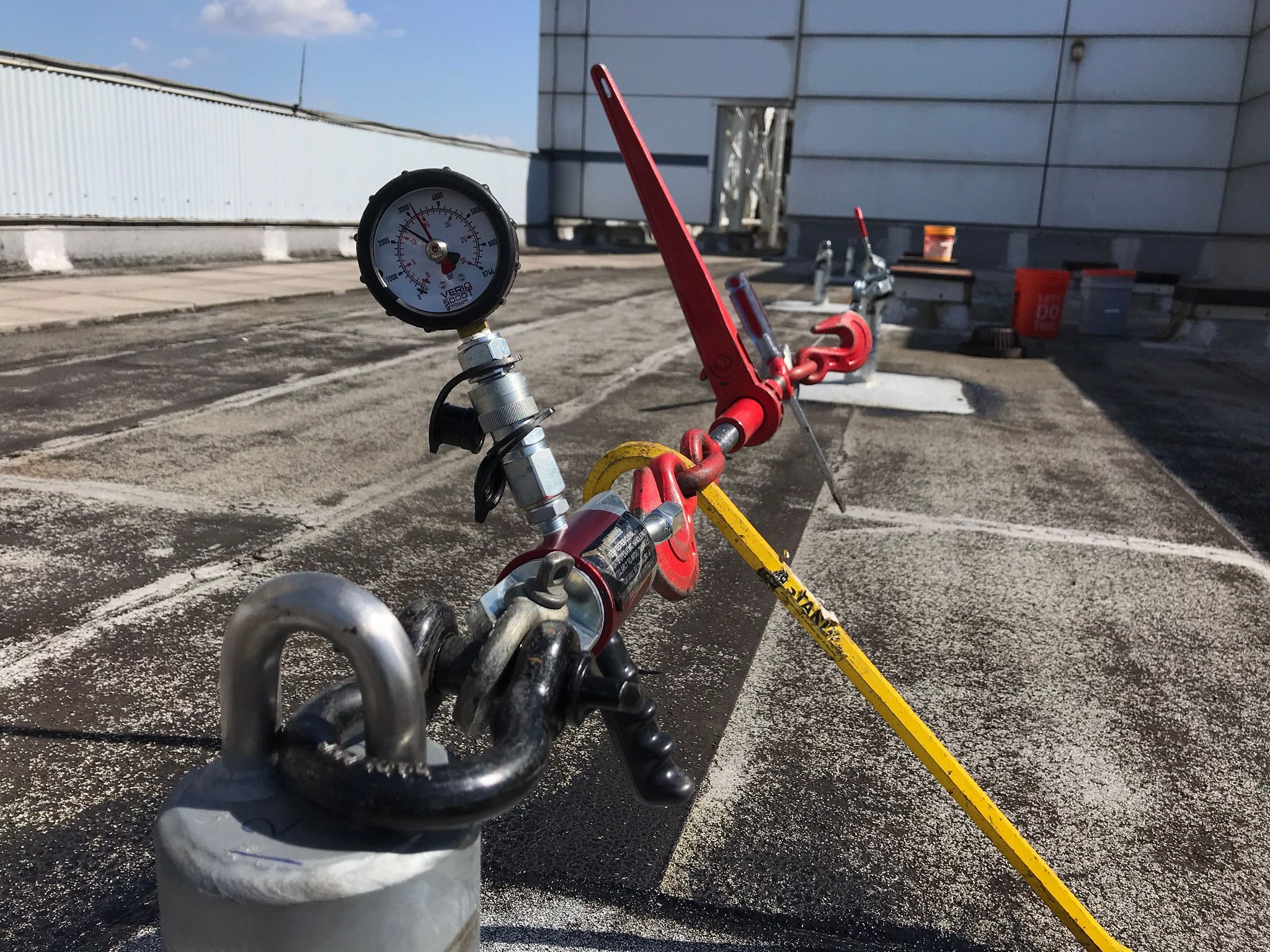Authorized Worker
- Section Held for Authorized Worker.
Rope Access Equipment
- General:
- Components used in any system shall be compatible.
- Rope access devices shall be constructed so that inadvertent detachment or removal from the rope is not possible when the device is used in accordance with the manufacturer’s instructions.
- All equipment shall minimize damage to the rope under normal use.
- Equipment shall be functional in the environment in which it is used.
- Standards:
- Rope access equipment should conform to standards relevant to the intended use. Seek guidance from the manufacturer of the equipment if there is any doubt about whether or not a particular standard is relevant to the intended use.
- Rope access equipment should satisfy the legal requirements in effect at the location of the work.
- If rope access is not directly regulated by an authority having jurisdiction at the location of the work, the rope access equipment should meet one or more of the relevant equipment standards established by an international, regional or national body such as those listed for each component.
- Testing methods for rope access equipment are beyond the scope of this document.
- Appropriate standards for each piece of equipment must be used to test for appropriate requirements such as a component’s minimum breaking strength.
- There are many possible appropriate standards. Each one may differ in its test methodology, weight range of the worker, and pass/fail requirements.
- The most commonly used standards are listed for each piece of equipment.
- Typical strength requirements may be listed for each piece of equipment to be used as a reference.
- The most critical element is to ensure that the equipment being used is appropriate for the job at hand.
- Certification:
- All equipment shall be manufactured under an ISO 9001 or similar quality management program.
- Care and Inspection of Equipment:
- Equipment shall be inspected and maintained according to manufacturer’s specifications.
- The Rope Access Program Administrator shall establish and monitor an equipment inspection and maintenance program to ensure that:
- Equipment inspection history can be traced from purchase to retirement.
- Equipment is stored according to manufacturer’s instructions.
- Equipment is retired in adherence to manufacturer’s criteria.
- Rope access technicians shall perform a functional and visual check before each use to confirm equipment serviceability.
- Rope access technicians shall ensure that equipment is properly stored.
- Records listing all equipment issued, referring to the original test or certificates of conformity should be kept.
- In some cases it will be helpful if they also have relevant comments noting where the equipment was used, its storage conditions, and any incidents which could affect its life (e.g. unusual loadings, use in chemical or gritty atmosphere, exposure to salt-air, etc.).
- The records should note when each piece of equipment was inspected, by whom and any remarks concerning its condition at that time.
- Backup System:
- The backup system shall:
- Conform to 10.1 General.
- Be maintained in a position as high as practical.
- Be compatible with rope type and diameter.
- Recommended selection criteria. The backup system should:
- Have a rating for rescue loads.
- The minimum strength of the backup system is based on the arrest force on the user.
- Recent testing has shown that the maximum arrest force may not be adequate in determining a safe arrest force on the user.
- The average arrest force should also be taken into account and may be more important to the user’s safety than maximum arrest force.
- ANSI/ASSE Z359.15 defines the maximum arrest force to not exceed 8 kN (1,800 lbf) and the average arrest force to not exceed 4 kN (900 lbf).
- CE EN 12841 (Type A) only requires the maximum braking force (maximum arrest force), as measured during the braking period to not exceed 6 kN (1,350 lbf).
- The length of the lanyard is not specified since other factors of the backup system will restrict the length.
- Factors include the free fall distance, how the backup system is used, and how the backup system is tested (e.g. an appropriate standard).
- The free fall distance refers to the distance fallen before the engagement of the backup device.
- Free fall distance does not include the distance fallen during deceleration (e.g. sliding of the backup device or deployment of a shock absorber).
- The distance fallen during deceleration should be covered in appropriate standards with specific information for each device located in the manufacturer’s instructions.
- In practice, clearance requirements must be determined from the total fall distance including free fall, deceleration of the backup device, rope stretch, and harness stretch.
- Examples of appropriate standards in accordance with 10.2.3 include:
- The backup system shall:
ANSI/ASSE Z359.15 (not tested for two-person load).
CSA Z259.2.5 (not tested for two-person load).
CE EN 353-2.
CE EN 12841, Type A.
- Harnesses:
- Harnesses shall:
- Conform to 10.1 General.
- Be of the full body type.
- If a two-piece full body harness is used, it shall be certified as a full body harness.
- Harnesses shall:
- Recommended selection criteria:
- Most rope access harnesses will have three primary attachment points:
- Sternal: Upper frontal attachment point typically used for connecting a backup device or backup device lanyard.
- Ventral (Waist): Lower frontal attachment point typically used for connecting work positioning devices such as lanyards, descenders, and ascenders.
- Dorsal: Backside attachment point located between the shoulder blades, typically used in fall arrest.
- Leg loops should be of sufficient width and design to support the wearer in a comfortable and safe working position while allowing unhindered operation of other equipment and tools.
- The harness should be compatible with a work seat.
- Most rope access harnesses will have three primary attachment points:
- Typically, the minimum breaking strength is 16 kN (3,600 lbf).
- Examples of appropriate standards in accordance with 10.2.3 include:
ANSI/ASSE Z359.11.
CSA Z259.10.
CE EN 361.
ISO 10333-1.
NFPA 1983.
- Connectors:
- Connectors shall conform to 10.1 General.
- Carabiners used to support human loads shall be of a locking type (e.g. screw-gate or auto-locking gate).
- Recommended selection criteria (SECTION HELD):
- Typically, the minimum breaking strength in the direction of loading is 22.2 kN (5,000 lbf).
- Examples of appropriate standards in accordance with include:
ANSI/ASSE Z359.12 (self-locking and self-closing types only).
CSA Z259.12.
CE EN 362 (screw links are Class Q).
ISO 10333-5 (self-locking and self-closing types only).
NFPA 1983.
- Descenders:
- Descenders shall:
- Conform to 10.1 General.
- Allow for controlled descent and braking.
- Recommended selection criteria. Descenders should:
- Be appropriate for the length of the descent.
- Enable the user to stop and work hands-free.
- For long descents, consideration should be given to the effects of rope-weight and heat dissipation on descender
- Consideration should also be given to reducing cumulative twisting of the rope.
- Examples of appropriate standards in accordance with include:
- Descenders shall:
CSA Z259.2.3.
CE EN 12841, Type C.
CE EN 341, Type A (rescue only).
ISO 22159.
NFPA 1983.
- Ascenders:
- Ascenders shall:
- Conform to 10.1 General.
- Require two or more deliberate actions by the user to be removed from the rope.
- Not slip under normal use.
- Recommended selection criteria. Ascenders should:
- Be easily adjustable when moving up and down the working line.
- Be suitable for specific use (e.g. mounted sternally).
- Have attachment points for device lanyards and other devices.
- Examples of appropriate standards in accordance with 10.2.3 include:
- Ascenders shall:
CE EN 12841, Type B.
CE EN 567.
NFPA 1983.
- Ropes:
- Ropes shall:
- Conform to 10.1 General.
- Be made from synthetic fibers.
- Examples of synthetic fibers include nylon, polyester, and aramid fibers.
- Consult with the manufacturer for the type and construction of ropes to be used in extreme environments.
- Recommended Selection Criteria.
- Life safety ropes should be selected which have an outer sheath that resists undue wear from edges and system components and tight enough to resist the ingress of dirt and grit.
- Ropes should be Static or Low Stretch.
- In special circumstances, dynamic rope may be appropriate to be used in place of static or low stretch rope. Dynamic safety rope should be of a kernmantle construction compliant with UIAA/CE (or comparable) standards for single climbing ropes.
- Typically, 11 mm rope is used. The CI 1801 minimum breaking strength for 11 mm rope is 26.7 kN (6,000 lbf).
- Examples of appropriate standards in accordance with 10.2.3 include:
- Ropes shall:
CI 1801.
ANSI Z359.15.
CE EN 1891, Type A.
NFPA 1983.
- Lanyards:
- Lanyards shall conform to 10.1 General.
- If a lanyard is used as part of a backup system, the work positioning lanyard shall comply with 10.5 Backup System.
CE EN354.
CE EN358.
CE EN89
ISO 10333-2.
- Helmets:
- Helmets shall:
- Conform to 10.1 General.
- Be suitable for the type of work being undertaken (e.g. electrical work).
- Have a chinstrap or other retention system to prevent the helmet from coming off the head, whether the user is upright or inverted.
- Properly fit the user.
- Recommended selection criteria. Helmets should:
- Allow unrestricted vision.
- Have the ability to mount accessories such as a visor or headlamp
- Examples of appropriate standards in accordance with 10.2.3 include:
- Helmets shall:
ANSI Z89.1, Type 1 or Type 2.
CSA Z94.1.
CE EN 397.
CE EN 14052.
CE EN 12492.
- 13. Pulleys.
- Pulleys shall:
- Conform to 10.1 General.
- Recommended selection criteria (SECTION HELD):
- Examples of appropriate standards in accordance with include:
- CE EN 12278.
- NFPA 1983.
- Pulleys shall:



